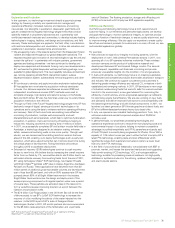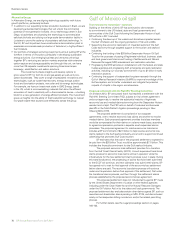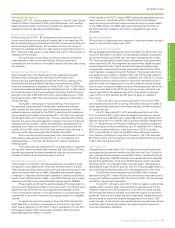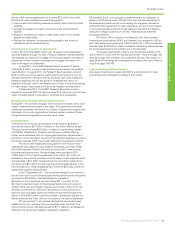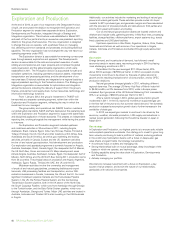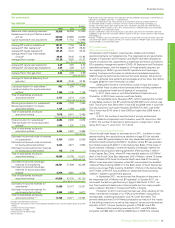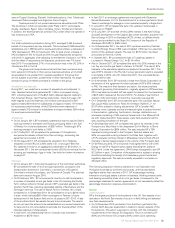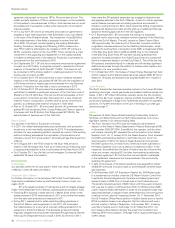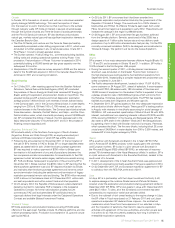BP 2011 Annual Report Download - page 77
Download and view the complete annual report
Please find page 77 of the 2011 BP annual report below. You can navigate through the pages in the report by either clicking on the pages listed below, or by using the keyword search tool below to find specific information within the annual report.
Business review: BP in more depth
BP Annual Report and Form 20-F 2011 75
Business review
Exploration and Production
In the upstream, our technology investment directly supports business
strategy by focusing on safety and operational risk management;
operational efficiency; increased recovery and reserves; and winning
new access. Our strengths in exploration, deepwater, giant fields and
gas are underpinned by flagship technology programmes that conduct
scientific research in proprietary laboratories and in partnership with
world-class research institutes and universities, to develop industry-leading
technologies in imaging, facilities, well design and completions, and field
recovery. These technologies are applied in the field, often in combination
with real-time data acquisition and visualization, to drive risk reduction and
excellence in exploration, developments and production.
• We are applying many of the lessons learned from the Deepwater Horizon
incident and response throughout our global deepwater operations. The
response required rapid innovation of new technologies to cap the well and
contain the spill and – in partnership with industry partners, government
agencies and leading universities – we have continued to develop and
deploy new equipment and standards. Among many new developments in
BP, we have built a global deepwater well cap and tooling package, now
available for global deployment. This new capability includes a containment
cap, remote operating vehicle (ROV) intervention system, subsea
dispersant injection system, subsea debris removal equipment, and other
tools.
• BP continues to develop and apply innovative exploration technologies.
BP has applied two novel seismic acquisition methods developed
in-house. Our distance separated simultaneous sources (DS3) and
independent simultaneous sources (ISS®) methods were used to
complete ultra-large, high density land seismic surveys in the Middle
East and North Africa. BP also has field trials under way to extend these
acquisition methods to the offshore.
• Through our Field of the Future® flagship technology programme, BP has
deployed a range of digital, sensing and control technologies in its
operations and is using the data to enhance real-time operating efficiency
and recovery. Field of the Future tools are enabling more effective
monitoring of production, multiple well components, and well
characteristics such as temperature, which help to optimize hydrocarbon
production. In addition, improved monitoring of facilities is helping to
reduce risk, reducing downtime and saving tens of millions of dollars.
• In 2011, we successfully completed BP well advisor module field trials in
Azerbaijan, a technology designed to aid decision making, enhance
safety, reduce cost and bring wells on line more quickly. Through well
advisor, we can harness real-time drilling data from sensors that see
ahead of the drill, enabling us to deploy technologies such as early kick
detection, which allow adjustments that can minimize down time during
this critical phase of development. Rolling field trials will continue
throughout 2012 to accelerate deployment.
• Enhanced oil recovery (EOR) technologies continue to push recovery
factors to new limits. We believe that by increasing the overall recovery
factor from our fields by 1%, we could be able to add 2 billion boe to our
estimated ultimate recovery from existing fields. As at the end of 2011,
BP, using its Designer Water® EOR technology, has treated 78 wells
with Bright Water™ particles (a BP idea) in Alaska, Argentina, Azerbaijan,
Pakistan and Russia. These applications have delivered more than 20
million barrels of additional gross recoverable volumes at a development
cost of less than $6 per barrel, and with an 80% success rate: BP has
pumped almost 90% of all Bright Water treatments in the industry.
Bright Water treatments involve the design and deployment of this
sweep-improving component with regular injection water over a period
of several days. These particles are activated deep in the reservoir to
form a waterflood sweep improving diversion at a point between the
injection and production wells.
• The $7.6 billion Clair Ridge project in the UK North Sea will be the first
offshore project to use BP’s LoSal® EOR technology to increase the
recovery of oil by modifying the salinity of the water injected into the
reservoir. (LoSal EOR is part of BP’s suite of Designer Water
technologies.) Earlier in 2011, BP and its partners also announced plans
for the $5 billion redevelopment of the Schiehallion and Loyal fields,
west of Shetland. The floating production, storage and offloading unit
(FPSO) is to be built with full polymer EOR application capability.
Refining and Marketing
Our Refining and Marketing technology focus is both operational and
customer facing. In our refineries and petrochemicals assets, we develop
and apply technology to monitor operational integrity, to optimize product
yields as a function of feedstock changes, to ensure quality attainment, and
to improve energy efficiency. We also apply our expertise to create quality
brand fuel and lubricant products for customers in on-road, off-road, air, sea
and industrial applications globally.
For example:
• We continued to expand our integrity monitoring systems, with the
deployment of over 1,000 wireless Permasense sensors in 2011, now
spanning all of our BP-operated refineries worldwide. These wireless
corrosion sensors are the product of collaborative research and
development between BP and Imperial College London. The sensors
enable frequent, repeatable wall-thickness monitoring and provide
previously unavailable insights into the condition of oil and gas assets.
• In fuels and lubricants, our technology focus is on creating sustainable,
differentiated and competitive products that enable advances in transport
and industry. We continue to support our partners and customers in
delivering greater energy efficiency and reduced CO2 emissions in both
established and emerging markets. In 2011, BP developed a new range
of industrial metalworking fluids that are both safer for workers and less
harmful to the environment, a new gear lubricant for maximizing the
efficiency of wind turbines, and co-engineered passenger car lubricants
for optimizing engine fuel efficiency. We are also working on new fuels
and lubricants that deliver improved fuel economy and compatibility with
the latest engine technology and with biofuel components. In 2011, we
launched our latest generation BP Ultimate gasoline and diesel fuels, and
BP’s first differentiated-performance heavy duty diesel offer.
• In July, we opened a new industrial technology centre in Turin, Italy. It
will serve customers across Europe and analyse about 30,000 oil
samples a year.
• In petrochemicals, our proprietary processing technologies and
operational experience continue to reduce the manufacturing costs and
environmental impact of our plants, helping to maintain competitive
advantage in purified terephthalic acid (PTA), paraxylene and acetic acid.
A third PTA plant is currently being engineered for Zhuhai, China. With a
capacity of 1.25 million tonnes per year it will be the first to employ BP’s
latest PTA technology, enabling scale and cost efficiencies which
significantly reduce both capital and conversion costs to a lower level
than any other PTA technology.
• In the field of unconventional feedstocks, we collaborate with KBR to
promote, market, and license the slurry-bed residue and coal-upgrading
Veba combi-cracking (VCC) technology. VCC is a hydrogen-addition
technology suitable for processing crude oil residuum into high-quality
distillates or synthetic crude oil in the refining, upstream-field upgrading
and coal-to-liquids sectors.
ISS®, Field of the Future®, Designer Water® and LoSal® are all trademarks of BP p.l.c.
Bright WaterTM is a trademark of Nalco Energy Services LP.












